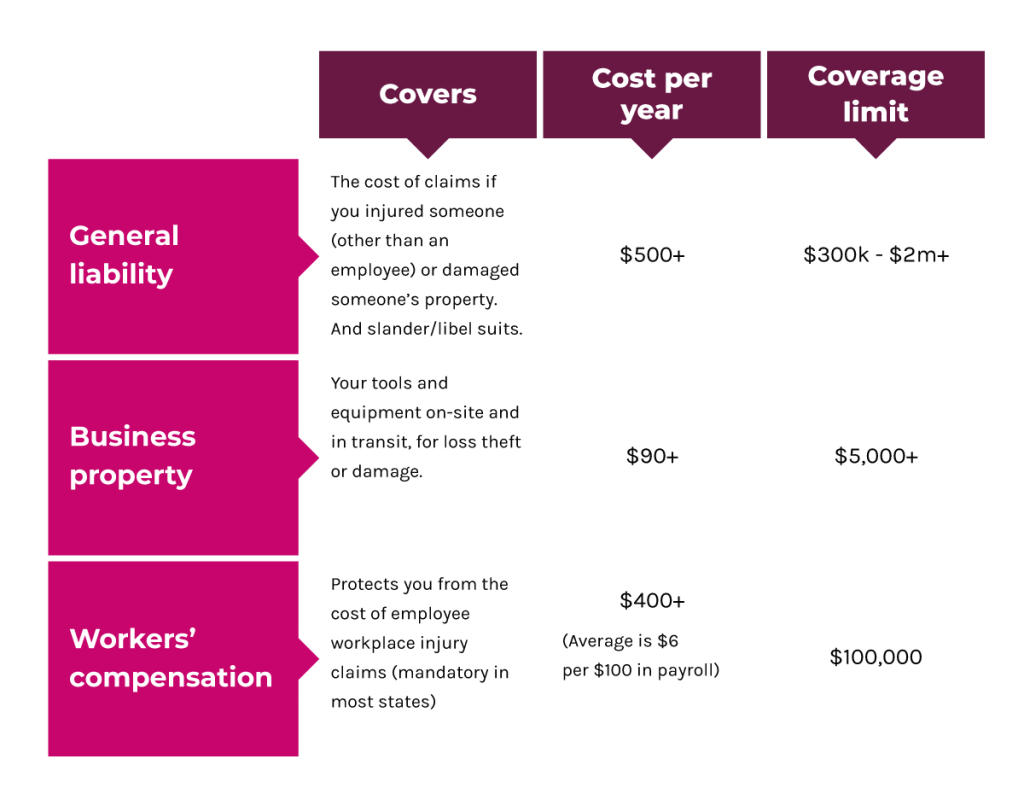
To understand the costs involved with landscaping insurance, the first thing to appreciate is we’re not talking about just one policy here.
Landscaping insurance is an umbrella term. It’s used to describe several different policies you might need if you’re in the landscaping or lawn care business.
Lawn care insurance is the same product but geared towards businesses who do lawn care and nothing else.
Each type of insurance is designed to cover the different risks you face as a landscaper or lawn care contractor.
Common landscaping and lawn care insurance policies and typical costs
Landscaping and lawn care insurance costs vary, depending on how many policies you buy, the coverage options you choose and the services you offer.
But as there are two or three policies most landscapers or lawn care contractors need, we’ll use those to give you an idea of the costs involved.
General liability — The cost of claims you injured someone (other than an employee) or damaged someone’s property. And slander/libel suits.
Business personal property — Your tools and equipment on-site and in transit, for loss, theft or damage.
Workers’ compensation — Protects you from the cost of employee workplace injury claims (mandatory in most states).

7 factors affecting landscaping and lawn care insurance costs
How much your landscaping or lawncare insurance costs varies from business to business. Though broadly speaking, landscaping insurance costs are often higher than that of a lawn care company.
As sole proprietor of a lawn care company, you might pay $500. Whereas if you run a larger landscaping firm with a couple of employees and offer services like patio and driveway construction, you could be looking at $5,000-$7,000+.
The costs are affected by the following factors:
1. Which services you offer
The landscaping or lawn care services you offer affect your policy premium. Insurers classify your business as lower risk if you offer straightforward lawn care and yard maintenance. So you’ll pay less for a policy than a large firm who also offers basic construction and outdoor lighting installation, for example.
A large landscaping company might pay, on average, around $1,600 a year for general liability insurance. While a landscape designer could pay as little as $500.
2. Where you’re based
Your business location can have a big impact on your landscaping or lawn care policy price. If you’re based in California, you’ll pay more than you would if you were located in Ohio.
But it’s not just the state you’re in that affects the price. Where you are in the state is a factor, too. If you run your business in a district where houses are expensive, you may find your insurance premium is higher.
3. Your annual business income
Generally, the higher the amount of money your business earns in a year, the higher the price of your policy. That’s because insurers view you as having greater potential exposure (so you have more to lose if you get sued).
4. The value of your equipment/property
This one’s pretty straightforward. The more your equipment is worth, the more you’ll pay to insure it. But don’t be tempted to undervalue your tools. If they get lost, stolen or damaged on a job, you need to know you can get them replaced, like for like. And fast.
5. Whether you have employees
If you have even one employee, workers’ comp insurance is a requirement in most states. And adding that policy to your landscaping insurance bundle will increase your overall cost.
6. Your payroll
The cost of workers’ comp insurance is worked out using your annual payroll amount. It increases depending on the kinds of risk your employees face and the salary you pay them.
7. The deductible you choose
A deductible is the amount you agree to contribute to the cost of a claim. Typically, the higher the deductible you pick, the lower your policy premium will be.
Just don’t be tempted to choose a high deductible if it’s one you realistically can’t afford to pay if there’s a claim.
Coverage limits
The coverage limit you choose will affect the amount your insurance provider will pay out on a claim. The higher your limit, the more your policy will cost.
There are two types of policy limit:
• A per-occurrence limit — the maximum amount your insurer will pay out for one single incident.
• An aggregate limit — the maximum amount your insurer will pay out for claims made during your policy period – usually a year.
Most small landscaping or lawn care businesses go for a general liability policy with a $1 million per-occurrence limit and a $2 million aggregate limit. But as your business grows, you may want to think about increasing your coverage limits.
Need our help?
We’ll be happy to talk through your landscaping or lawn care insurance costs with you. And we can get you the coverage that’s right for your business, fast.
Just give us a call at 978.344.4215 with any questions.
general liability insurancelandscaping and lawncareworkers' comp